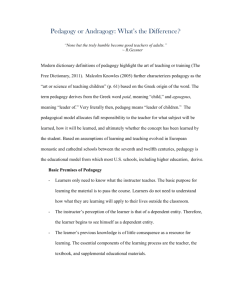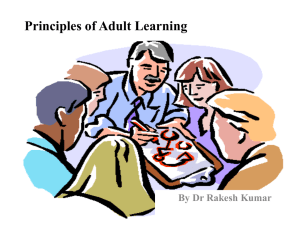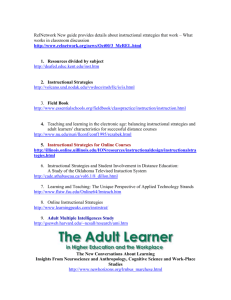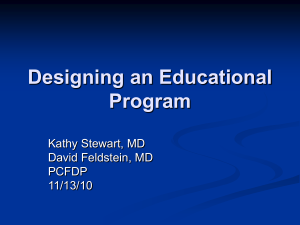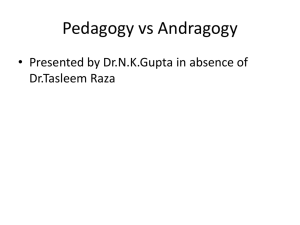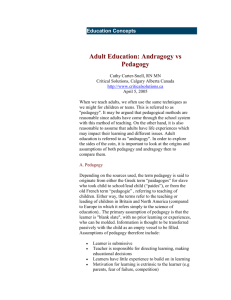Complete paper available
advertisement
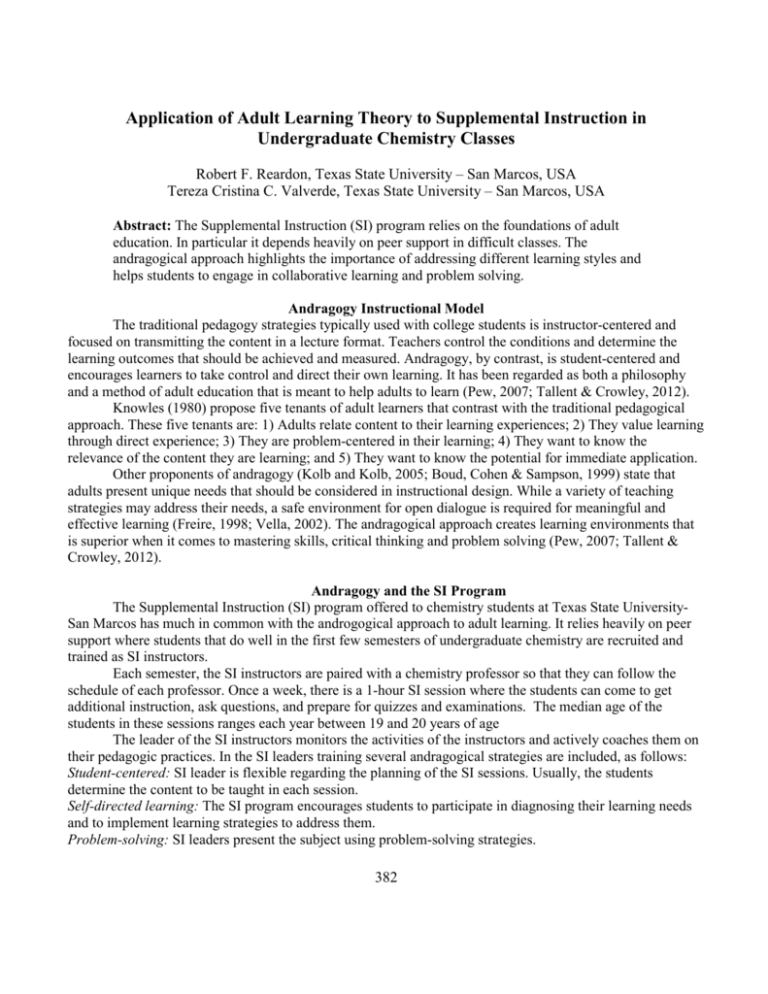
Application of Adult Learning Theory to Supplemental Instruction in Undergraduate Chemistry Classes Robert F. Reardon, Texas State University – San Marcos, USA Tereza Cristina C. Valverde, Texas State University – San Marcos, USA Abstract: The Supplemental Instruction (SI) program relies on the foundations of adult education. In particular it depends heavily on peer support in difficult classes. The andragogical approach highlights the importance of addressing different learning styles and helps students to engage in collaborative learning and problem solving. Andragogy Instructional Model The traditional pedagogy strategies typically used with college students is instructor-centered and focused on transmitting the content in a lecture format. Teachers control the conditions and determine the learning outcomes that should be achieved and measured. Andragogy, by contrast, is student-centered and encourages learners to take control and direct their own learning. It has been regarded as both a philosophy and a method of adult education that is meant to help adults to learn (Pew, 2007; Tallent & Crowley, 2012). Knowles (1980) propose five tenants of adult learners that contrast with the traditional pedagogical approach. These five tenants are: 1) Adults relate content to their learning experiences; 2) They value learning through direct experience; 3) They are problem-centered in their learning; 4) They want to know the relevance of the content they are learning; and 5) They want to know the potential for immediate application. Other proponents of andragogy (Kolb and Kolb, 2005; Boud, Cohen & Sampson, 1999) state that adults present unique needs that should be considered in instructional design. While a variety of teaching strategies may address their needs, a safe environment for open dialogue is required for meaningful and effective learning (Freire, 1998; Vella, 2002). The andragogical approach creates learning environments that is superior when it comes to mastering skills, critical thinking and problem solving (Pew, 2007; Tallent & Crowley, 2012). Andragogy and the SI Program The Supplemental Instruction (SI) program offered to chemistry students at Texas State UniversitySan Marcos has much in common with the androgogical approach to adult learning. It relies heavily on peer support where students that do well in the first few semesters of undergraduate chemistry are recruited and trained as SI instructors. Each semester, the SI instructors are paired with a chemistry professor so that they can follow the schedule of each professor. Once a week, there is a 1-hour SI session where the students can come to get additional instruction, ask questions, and prepare for quizzes and examinations. The median age of the students in these sessions ranges each year between 19 and 20 years of age The leader of the SI instructors monitors the activities of the instructors and actively coaches them on their pedagogic practices. In the SI leaders training several andragogical strategies are included, as follows: Student-centered: SI leader is flexible regarding the planning of the SI sessions. Usually, the students determine the content to be taught in each session. Self-directed learning: The SI program encourages students to participate in diagnosing their learning needs and to implement learning strategies to address them. Problem-solving: SI leaders present the subject using problem-solving strategies. 382 Immediacy: The subject matter is addressed and new concepts are applied in problems brought by the students. Redirecting questions: SI leaders are instructed to do not answer directly the questions or doubts students bring to sessions, but instead to guide the students in how to find the answers with the help of their peers. Learning styles: Diversity in teaching strategies is encouraged, taking into consideration differences in learning styles. Some of the strategies include games, small group and team work and hands-on learning. Collaborative learning: Peers work collaboratively trying to solve the problems (quizzes and homework) presented in the lectures. Peer learning increases the possibilities for students to engage in reflection and exploration of ideas. The sessions are dynamically structured to meet the needs of the students. The SI instructors try to get to know the students and match the activities to the learning styles of the students and the material that was covered during the lectures. When questions arise, the instructors will attempt to involve other students in the answering of questions. In addition, the instructors try to make certain that all students feel safe in asking questions. As part of an ongoing analysis we carried out qualitative interviews of chemistry students enrolled in the SI program. These interviews revealed that students appreciated the andragogical approach. Many felt their questions might never have been given a voice in lecture. For many of them, this is one of the first learning opportunities in higher education where they feel free to discuss material in the course. References Boud, D., Cohen, R. & Sampson, J. (1999). Peer Learning and Assessment. Assessment and Evaluation in Higher Education, 24(4), 413-426. Freire, P. (1998). Pedagogy of freedom: Ethics, democracy and civic courage (P. Clarke, trans.). Lanhram, Md: Rowman & Littlefield Publishers. Knowles, M. S. (1980). The modern practice of adult education: From pedagogy to andragogy. New York: Cambridge. Kolb, A. Y. & Kolb, D. A. (2005). Learning Styles and Learning Spaces: Enhancing Experiential Learning in Higher Education. Academy of Management Learning & Education, 4(2), 193-212. Pew, S. (2007). Andragogy and pedagogy as foundational theory for student motivation in higher education. InSight: A Collection of Faculty Scholarship, 2, 14-25. Retrieved from http://search.ebscohost.com.libproxy.txstate.edu/login.aspx?direct=true&db=eric&AN=EJ864274&sit e=eds-live&scope=site Tallent, R. J., & Crowley, K. (2012). Facilitating creativity in a non-creative world: Helping students develop Critical/Creative thinking skills using andragogy in the classroom. Florida Communication Journal, 40(2), 23-34. Vella, J. (2002). Learning to listen. Learning to teach. The power of dialogue in educating adults. San Francisco: Jossey-Bass. 383
